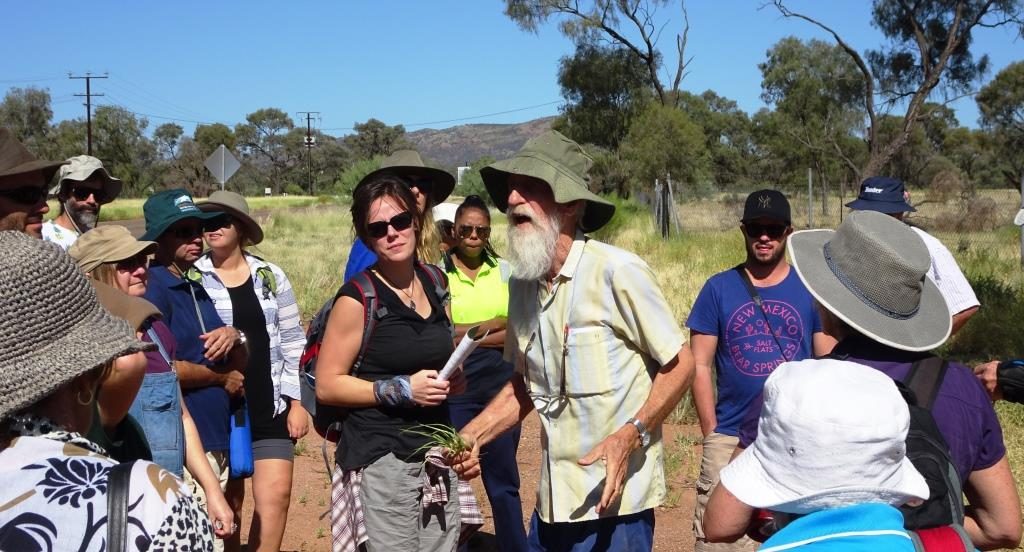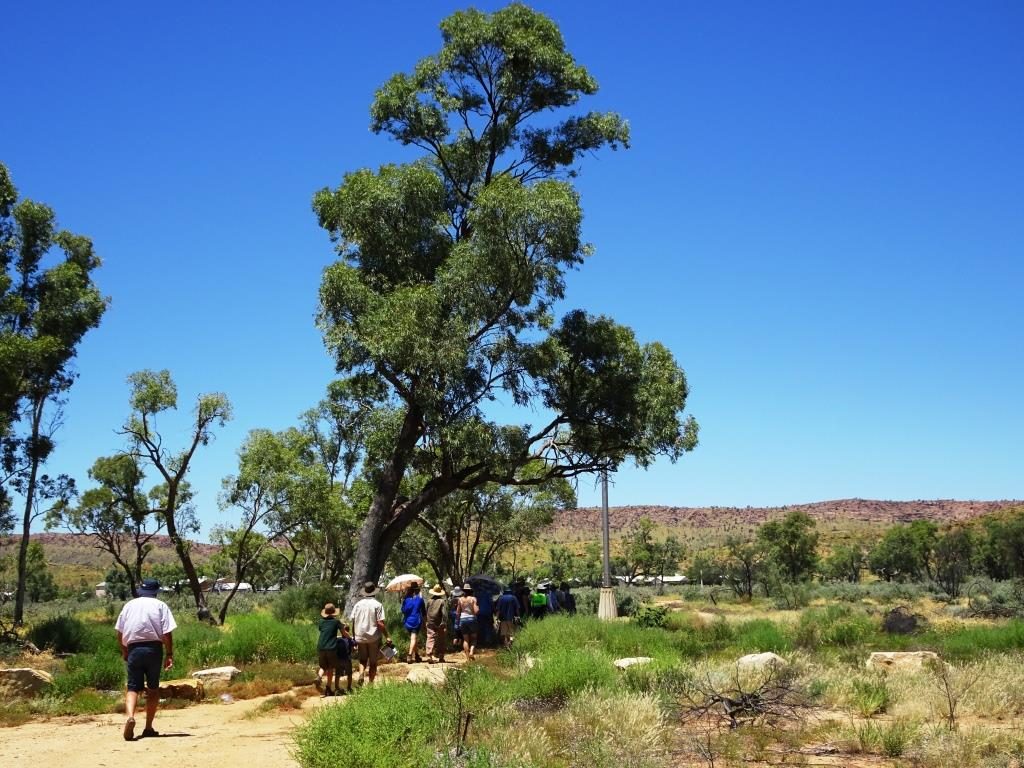Land for Wildlife kicked off last weekend with its first collaborative workshop for 2017 – a Buffel Busters inspiration tour of Alice Springs. Arid Lands Environment Centre hosted the event as part of their Biodiversity Matters initiative, with Land for Wildlife supporting the tour to a range of Land for Wildlife properties and other local landcare properties. This was supported by Territory Natural Resource Management, Desert Knowledge Australia, Olive Pink Botanic Garden and Alice Springs Landcare Inc. The workshop was attended by 25 keen Buffel Busters, seeking inspiration for the removal of the pesky introduced Buffel Grass (Cenchrus ciliaris). The drive gave the workshop participants several chances to compare Buffel-laden versus buffel-free sites, including identification of some of the native grasses, forbs and shrubs that can germinate in the absence of Buffel.
The first stop on the tour was made to the property of local botanist and grass expert, Peter Latz. Peter has spent many years on his eight hectare plot, removing Buffel Grass, Couch (Cynodon dactylon) and invasive Lovegrasses (two of the Eragrostis sp.). Peter, along with several neighbours, has removed Buffel from adjacent drainage lines, which he says is one of the main incoming sources of seed to his property. Buffel Grass has resulted in several large fires incinerating some of the old Ironwood (Acacia estrophiolata) trees, one of the main problems with this introduced grass, according to ‘Latzi’. The effort to remove Buffel Grass, which has been a ten-year task, has resulted in greater plant and animal diversity on his block.
The removal of Buffel has been accomplished by spraying large patches, chipping out smaller pockets with a hoe or mattock. He suggests that you should never spray Buffel once the seeds have fallen, as they are tough enough that they become resistant to herbicides. The Buffel should be sprayed twice and then removed by mechanical means (hoe or mattock). Peter states that they key to effective Buffel removal is to be present during the active growing season (following heavy rains), so that the plants and seed heads can be removed before they are released from the plant.
Peter argues that while Buffel Grass is invasive and responsible for promoting more intense fires, it isn’t as bad as some of the other grasses that are taking hold in the area, such as Couch and African/Stinking Lovegrass. Buffel Grass may be helping to keep some of the other invasive weeds at bay. Buffel makes good mulch and growing plants stabilise the soil in areas of erosion concern, however the seeds must be removed to prevent the spread of the grass. Buffel grass also acts as a nutrient recycler, putting carbon back into the soil, and increasing soil fertility for when the natives regenerate. However this isn’t long-term and so nutrition declines over time in grass-dominated ecosystems, requiring phosphate to strike a balance (or the growth of legumes).
Peter recommended a book ‘Where Do Camels Belong’ by Dr Ken Thompson, which suggests that invasive species vigour declines after 50 years and becomes part of the landscape. This suggests that Buffel grass populations will eventually diminish in areas of early establishment. However, the native seed bank needs to be replenished in order for the natives to regenerate, and hence Buffel control is still needed in the meantime. This seed stock also provides food for a range of local wildlife, keeping populations of invertebrates, birds and native mice well-fed.
The second site visited was the verge of Schaber Road, where Bruce Simmons has focused his Buffel bashing efforts for many years. Originally, Bruce was concerned about the effects of erosion when removing Buffel but went ahead with some advice from the experts. He convinced his neighbours to get involved, with many others in the street taking part in the Buffel Grass removal quest.
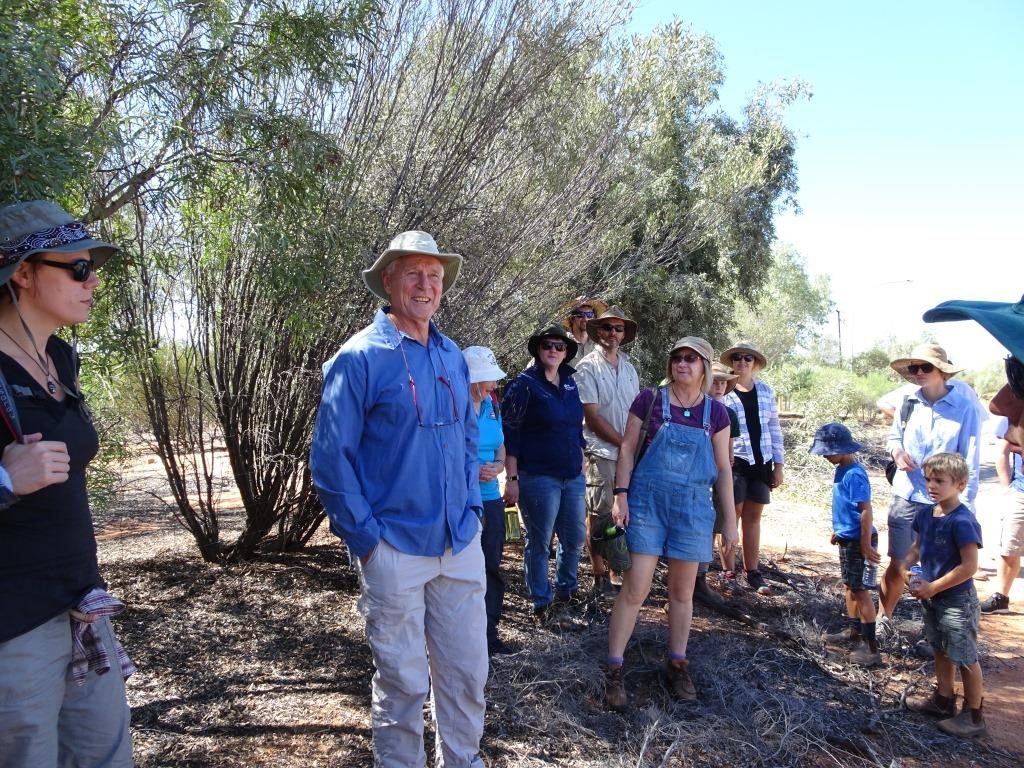
Bruce helps out at the Alice Springs Community Garden, an Arid Lands Environment Centre initiative and Garden for Wildlife property located in Eastside. The Buffel Grass pulled by Bruce and others is used to create compost for the gardens, but he states that the Buffel can also be placed directly under the base of fruit trees as mulch. He reinstates the suggestion that Buffel Grass removal requires persistence but once the bulk has been removed, maintaining the native verge requires minimal effort.
Buffel Grass seeds wash in from neighbouring areas in the drainage lines and so the recent rains have been a challenge, germinating a host of Buffel seeds along the verge. The native forbs that have returned to the verge, include Variable Daisy (Brachycome ciliaris complex), Woolly Oat Grass (Enneapogon polyphyllus), Erect Kerosene Grass (Aristida holathera) and Golden Everlasting (Xerochrysum bracteatum), among others. These natives provide habitat and foraging space for a range of birds, with birds such as Rainbow Bee-eaters (Merops ornatus) and Sacred Kingfishers (Todiramphus sanctus) calling the street home.
Debbie Page is a keen Buffel Buster with a Land for Wildlife property in Ross, and this made for an inspiring third stop. Debbie is eager to motivate and inspire land owners to remove Buffel on their own properties. She claims that effective Buffel control is about awareness, which Debbie gained through seeking advice from various contacts around Alice Springs. Debbie’s journey to a Buffel-free property came from three catalysts: Land for Wildlife and the technical support provided by the nature conservation program, Rosalie Breen and her efforts spraying Buffel at OLSH in Alice Springs, and some friends in the area, Carmel and David Leonard (also a Land for Wildlife property in the day). With some inspiration from others and the phrase ‘Dream, Believe, Create, Succeed’, she took up the Buffel removal challenge, though found it daunting at first. Debbie doesn’t attempt to convince her neighbours to remove Buffel, though she confesses that she has been known to jump the fence and spray clumps of Buffel in the early hours of the morning, and she can see that they have become Buffel Busters through watching her actions.
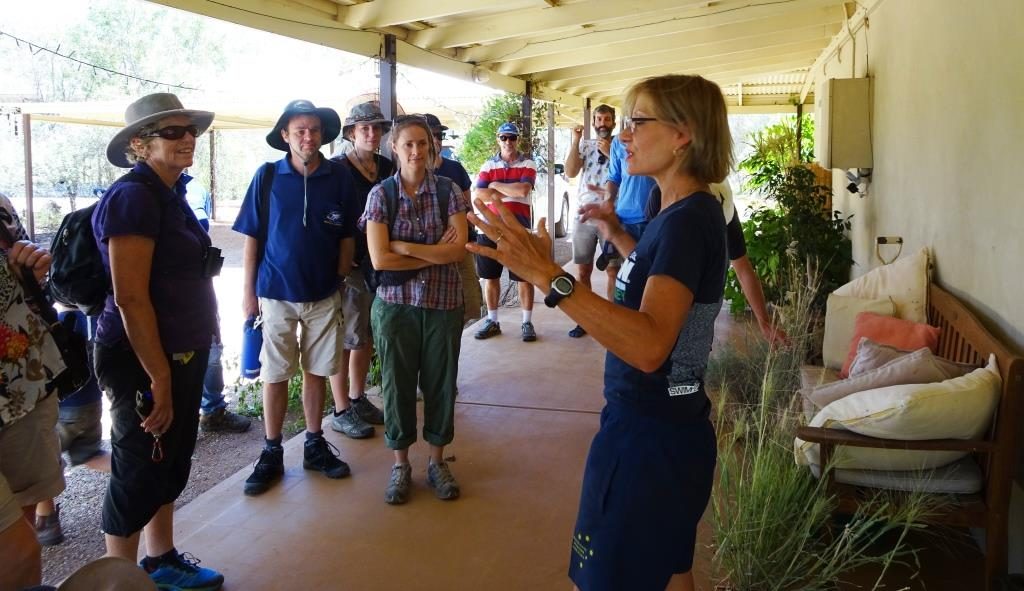
Debbie started her Buffel Busting efforts with a small spray pack, Glyphosate 360 and the appropriate safety equipment. Debbie suggested that a small amount of eco-friendly detergent can be placed in the spray pack to act as a surfactant, and Peter Latz added that sulphate ammonia can also be added to increase potency of the mix.
Debbie would find a window of opportunity after rain when the conditions suited spraying and would do an hour or two of spraying in the morning on her two hectare property. She states that the task has taken her four years, but the reward of native birds such as Splendid Fairy-wrens (Malurus splendens) and Quails (Turnix sp.) returning to her block is worth the hard work and she has enjoyed the challenge. Debbie recommends getting in touch with your property and becoming aware of the value that Buffel-removal can provide, as selectively spraying and watching the native understorey returning gives her a sense of accomplishment. Debbie’s property is now home to a huge variety of native grasses, such as Woolly Oat Grass (Enneapogon polyphyllus), Erect Kerosene Grass (Aristida holathera), Wiregrass (Aristida arida), Silky Bluegrass (Dichanthium sericeum subsp. sericeum), Native Millet (Panicum decompositum s.lat.), Silky Browntop (Eulalia aurea), and Curly Wiregrass (Aristida inaequiglumis).
The Buffel Busters Tour of Alice Springs made its way to Ankerre Ankerre, also known as the Coolabah Swamp, in Eastside. Jude Prichard and Alice Springs Landcare Inc has been working to remove Buffel Grass and other natives from the area for approximately four years, with amazing results. The Coolabah population has slowly started regenerating, with a few seedlings becoming established in recent months. They have managed to establish the native flora in the area, which is contributing to a solid seedbank, which they feel they are custodians of for future generations. Jude confirmed that the maintenance effort required is now minimal, so long as the landcare group can remove the plants before they seed.
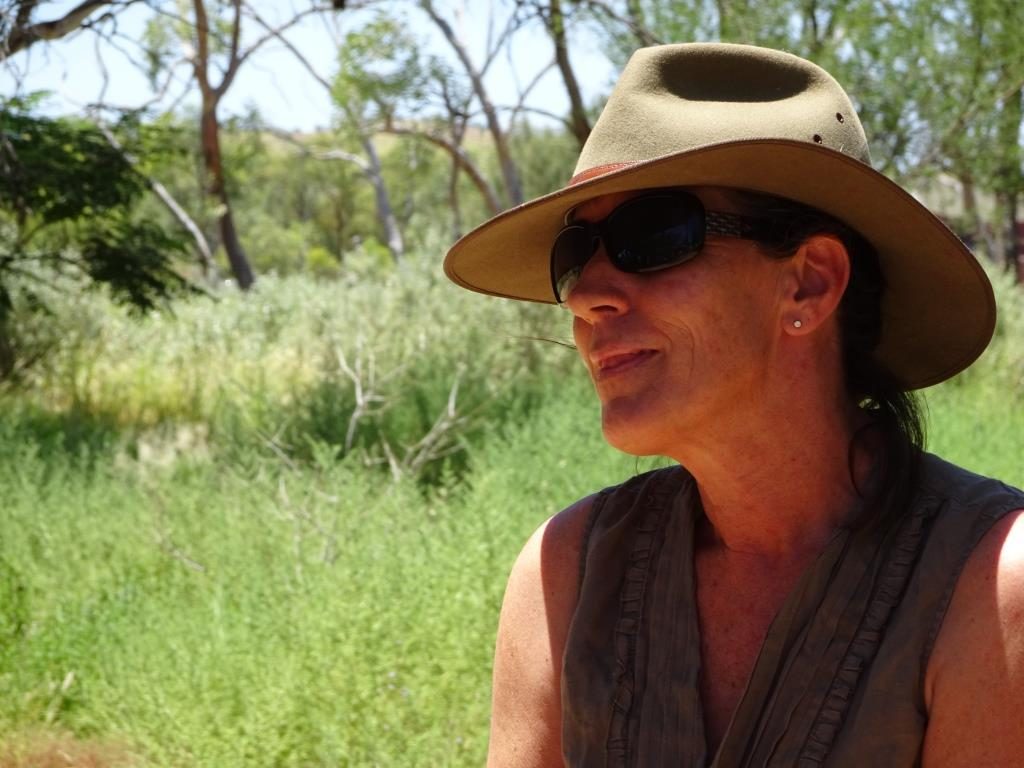
Jude explained how the large trees were protected from fire as the first strategy and once the main areas had been cleared of Buffel, the location site-lines were opened up to change perception of the area from a wasteland to a place of beauty and significance. She suggests setting goals, with small areas dealt with at a time and expanding from there.
The final stop of the tour was to Olive Pink Botanic Garden, where Doug McDougall showed the participants the hard work that the Green Army team (and other volunteers) had been doing to remove Buffel Grass on Nurse’s Hill. The Buffel Busters in the garden use a bio-friendly food dye in the spray pack so that they can clearly see the areas that have been sprayed to prevent waste of chemical. Visitors to the botanic garden are now met with an array of beautiful flowering native plants, as well as birds, Euros (Macropus robustus) and Black-footed Rock Wallabies (Petrogale lateralis).
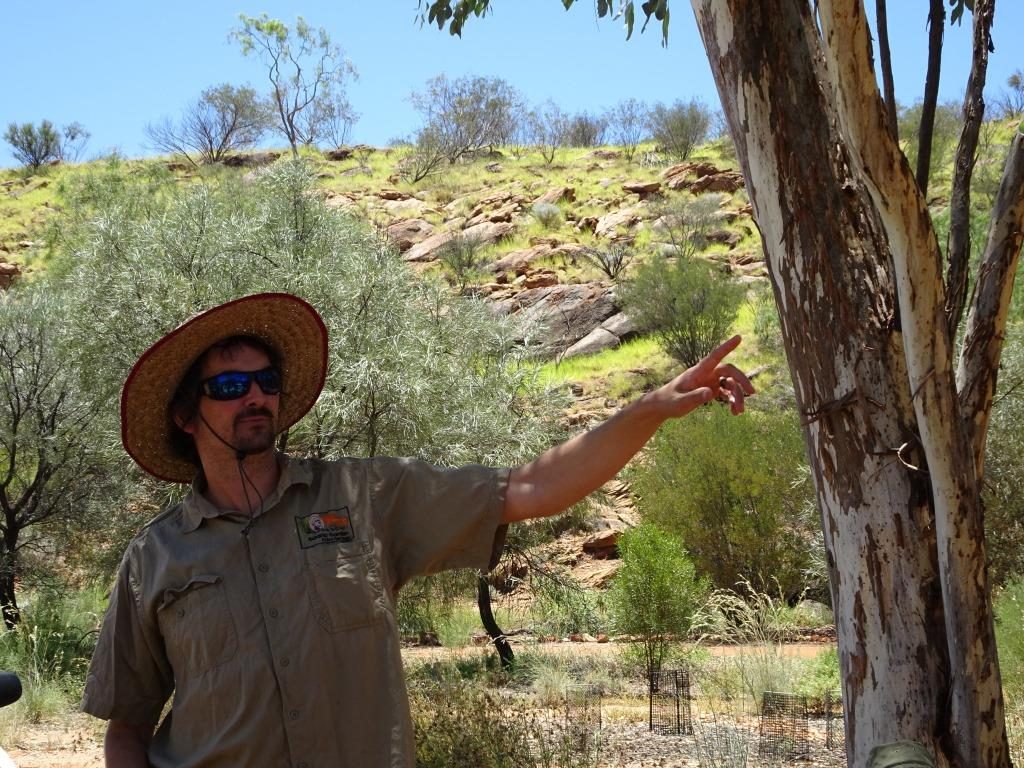
Many thanks go to the participants for taking part and to the Buffel Busters for opening your homes and gardens to the eagre Busters-to-be – providing so much inspiration. Thanks go to the Arid Lands Environment Centre for hosting the event and all of the supporters for making the event such a success.
A video of the day is in the making and will be released soon, so you can get up to speed with the inspirational words of the Buffel Busters (Stay posted).

